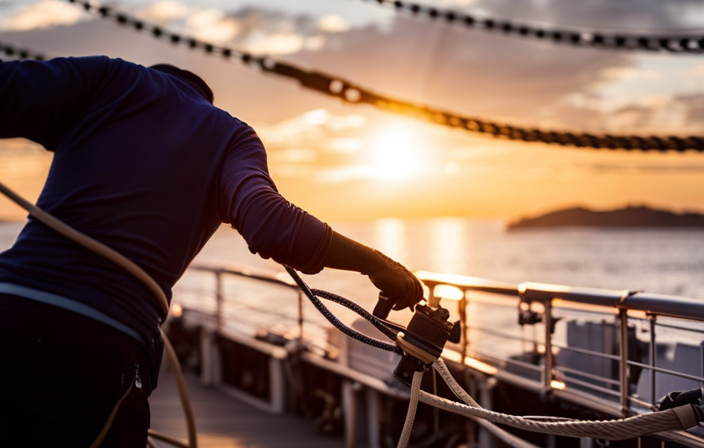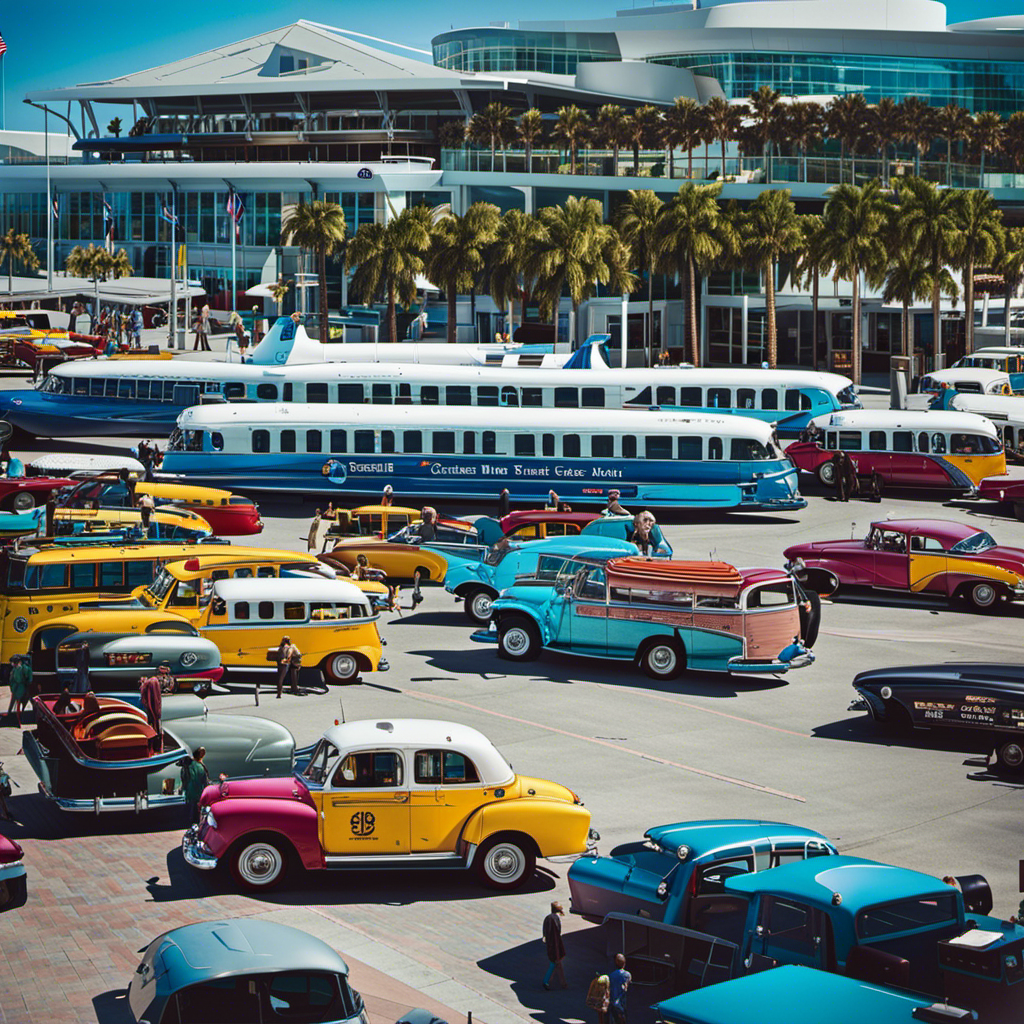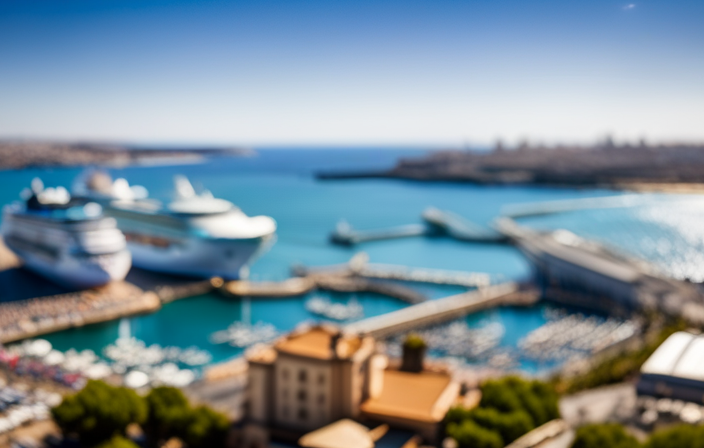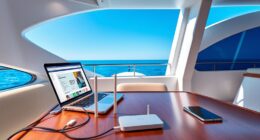Ah, the majestic cruise liner — a roving urban sprawl of lavishness and thrill. But, have you ever thought about what powers this enormous vessel, filled to the brim with countless indulgences and lively pursuits, keeping it perpetually alive?
Well, my curious friends, prepare to be enlightened. In this article, we will delve into the fascinating world of cruise ship electricity.
From onboard generators that hum with power to shore power connections that keep us connected to the grid, we will unravel the secrets behind this electrifying spectacle.
But it doesn’t stop there. We will also explore cutting-edge battery technology, energy efficiency measures, and even renewable energy sources that are being harnessed to minimize the environmental impact.
So, join me on this electrifying journey as we uncover the inner workings of how cruise ships get their juice. It’s time to power up and set sail into a world of knowledge and wonder.
Key Takeaways
- Cruise ships rely on onboard generators fueled by diesel or natural gas to produce electrical power.
- Port facilities provide infrastructure for cruise ships to connect to shore power, reducing reliance on onboard generators.
- Cruise ships have a complex network of electrical systems managed through electrical panels and switchboards.
- The cruise industry is continuously evolving to adopt new technologies, such as renewable energy sources and fuel cell technology, to improve energy efficiency and reduce emissions.
Onboard Generators
Cruise ships rely on onboard generators to power their electrical systems. These generators are fueled by various onboard fuel sources, such as diesel or natural gas, which are stored in designated fuel tanks.
The fuel is then burned in the generators’ combustion engines to produce mechanical energy. This mechanical energy is converted into electrical energy through the use of alternators or generators.
The generated electricity is then distributed throughout the ship’s electrical systems via a complex power distribution network. This network includes transformers, switchboards, and circuit breakers to ensure the electricity is delivered to different areas and systems on the ship.
As we transition into the next section about shore power connections, it is important to note that cruise ships can also connect to shore power when docked, allowing them to rely on external power sources rather than their onboard generators.
Shore Power Connections
When it comes to shore power connections on cruise ships, there are three key points to consider: port facilities, electrical infrastructure, and environmental benefits.
Firstly, port facilities play a crucial role in providing the necessary infrastructure for cruise ships to connect to shore power. This includes the availability of appropriate docking facilities and the capacity to handle the electrical demands of the ship.
Secondly, the ship’s electrical infrastructure must be compatible with the shore power connection, ensuring a seamless transfer of electricity from the port to the ship.
Finally, the use of shore power connections offers significant environmental benefits, as it reduces the reliance on onboard generators and decreases emissions, contributing to a cleaner and more sustainable cruise industry.
Port Facilities
As you step onto the dock, the port facilities become a lifeline for cruise ships, providing the vital connection to electricity that keeps them running smoothly. Here are three key aspects of port facilities that enable cruise ships to receive electricity:
-
Berth infrastructure: Ports are equipped with specialized berths that are designed to accommodate cruise ships. These berths are equipped with electrical connections, enabling ships to plug in and receive a stable power supply.
-
Shore power systems: Port facilities are equipped with shore power systems, also known as cold ironing or alternative maritime power (AMP) systems. These systems allow cruise ships to connect to the local electrical grid, eliminating the need to rely on their onboard generators.
-
Power capacity: Port facilities have the necessary electrical infrastructure to meet the power demands of multiple cruise ships simultaneously. This ensures that each ship can receive the required amount of electricity without overloading the system.
With the port facilities providing the necessary electrical infrastructure, cruise ships can reliably receive the power they need for all onboard operations. This seamless connection to electricity sets the stage for exploring the subsequent section about the ship’s electrical infrastructure.
Electrical Infrastructure
Once you step onboard, you’ll be amazed by the intricate electrical infrastructure that powers the entire ship. Cruise ships have a complex network of electrical systems in place to ensure a safe and reliable power supply. Electrical safety measures are implemented throughout the ship to prevent any potential hazards. Power distribution is managed through a series of electrical panels and switchboards, which control and distribute electricity to various areas of the ship. To give you a better idea of the scale of the electrical infrastructure on a cruise ship, here is a table showcasing some key components:
| Component | Function |
|---|---|
| Electrical panels | Control and distribute electricity |
| Switchboards | Manage power distribution |
| Generators | Produce electricity |
The robust electrical infrastructure not only ensures the ship’s operations but also brings numerous environmental benefits.
Environmental Benefits
Imagine stepping onboard and witnessing the impressive electrical infrastructure that powers the entire ship, providing not only reliable power but also numerous environmental benefits.
Cruise ships are continuously implementing reduction strategies and green initiatives to minimize their impact on the environment. One of the major environmental benefits of cruise ship electrical infrastructure is the reduction of air pollution. By using shore power or onboard scrubbers, cruise ships are able to significantly reduce emissions of harmful pollutants like sulfur dioxide and nitrogen oxide.
Additionally, the use of modern, energy-efficient technologies such as LED lighting and advanced HVAC systems further contribute to reducing the ship’s carbon footprint. These green initiatives not only benefit the environment but also enhance the overall experience for passengers.
Transitioning to battery technology allows cruise ships to further improve their environmental performance by reducing reliance on fossil fuels.
Battery Technology
To keep the colossal cruise ship powered up, you’ll need to dive into the electrifying world of battery technology. Battery storage is a crucial component in the energy management system of a cruise ship. These advanced batteries are designed to store and release electricity efficiently, providing power during times when the ship’s engines are not running or when the demand for electricity is high. They are typically located in dedicated battery rooms, where they can be easily monitored and maintained.
To illustrate the importance of battery technology in cruise ships, consider the following table:
| Benefits of Battery Technology in Cruise Ships | Challenges of Battery Technology in Cruise Ships |
|---|---|
| Enhanced energy storage capacity | High initial cost |
| Improved energy efficiency | Limited battery lifespan |
| Reduced emissions | Limited charging infrastructure |
Battery technology is just one piece of the puzzle when it comes to powering cruise ships. In the next section, we will explore energy efficiency measures that further contribute to sustainable operations.
Energy Efficiency Measures
Energy efficiency measures are crucial for ensuring sustainable operations on cruise ships. By implementing energy-efficient technologies and strategies, cruise ships can significantly reduce their environmental impact. Here are three key energy efficiency measures employed on these massive vessels:
-
Advanced lighting systems: Cruise ships use energy-efficient LED lighting throughout the ship, minimizing energy consumption and maximizing efficiency.
-
Waste heat recovery systems: The waste heat generated by the ship’s engines and other machinery is captured and used to produce electricity or heat water. This reduces the need for additional energy sources.
-
Hull design optimization: Cruise ships are designed with streamlined hull shapes and special coatings to reduce drag and increase fuel efficiency. This ultimately saves energy.
By incorporating these energy efficiency measures, cruise ships can operate in a more environmentally friendly manner. The next step towards achieving even greater sustainability onboard these vessels is transitioning to renewable energy sources.
Renewable Energy Sources
Transform your cruise ship experience with the power of renewable energy sources.
Renewable energy integration has become a crucial aspect in the quest for sustainable power solutions in the cruise ship industry. By harnessing the energy from renewable sources such as solar, wind, and hydro, cruise ships can significantly reduce their reliance on fossil fuels and minimize their environmental impact.
Incorporating advanced technologies and innovative systems, these ships are now equipped with solar panels, wind turbines, and hydroelectric generators to generate electricity on board. These renewable energy sources provide a clean and efficient alternative to traditional fuel-powered generators.
By integrating renewable energy into cruise ship operations, we are paving the way for a greener and more sustainable future for the cruise industry.
Transitioning into the subsequent section about fuel cell technology, this cutting-edge technology offers yet another promising solution for powering cruise ships.
Fuel Cell Technology
Fuel cell technology, with its futuristic appeal and silent operation, brings a whisper of innovation to the heart of cruise ship power systems.
Fuel cell applications have gained traction in recent years as a clean and efficient way to generate electricity. One such application is the use of hydrogen fuel cells, which produce electricity through an electrochemical reaction between hydrogen and oxygen. This technology eliminates the need for traditional combustion engines, reducing emissions and noise pollution.
The benefits of fuel cell technology on cruise ships are numerous, including improved energy efficiency, lower greenhouse gas emissions, and enhanced passenger experience due to reduced vibrations and noise.
Fuel cells are a promising solution for powering cruise ships, aligning with the industry’s increasing focus on sustainable practices. Moving forward, energy conservation practices will be explored to further optimize cruise ship power systems.
Energy Conservation Practices
Transition: Now let’s delve into the current subtopic of energy conservation practices employed by cruise ships.
As a cruise ship engineer, I am constantly seeking ways to optimize energy usage and reduce environmental impact. Cruise ships are equipped with a range of energy-saving technologies and sustainable power sources to achieve this goal. These technologies include LED lighting systems, which consume significantly less electricity than traditional incandescent bulbs. Additionally, advanced power management systems automatically adjust the power supply to different areas of the ship based on demand, minimizing wastage.
Another key method is the implementation of shore power connections, allowing ships to connect to the local electrical grid while docked, reducing the need for onboard generators. Furthermore, cruise ships are increasingly adopting renewable energy sources such as solar panels and wind turbines to supplement their power requirements.
In the next section, we will explore the critical aspect of emergency power systems, which ensure the safety and functionality of a cruise ship during unforeseen events.
Emergency Power Systems
In emergency power systems, backup generators play a crucial role. They ensure uninterrupted power supply during critical situations. These generators are designed to kick in automatically when the main power source fails. They provide electricity to essential systems and equipment onboard.
Redundancy measures are also implemented to enhance the reliability of emergency power systems. Multiple backup generators and redundant power distribution systems are put in place.
Safety protocols are implemented to ensure the proper operation and maintenance of emergency power systems. These protocols include regular inspections, testing, and training for crew members.
Backup Generators
Did you know that cruise ships have backup generators to ensure a constant supply of electricity, even in the most unexpected situations? These backup power systems are crucial for emergency response and maintaining the essential functions of the ship.
Here are three key features of cruise ship backup generators:
-
Redundancy: Cruise ships typically have multiple backup generators to ensure redundancy. This means that even if one generator fails, there are others ready to take over and provide electricity.
-
Fuel Capacity: Backup generators on cruise ships have a large fuel capacity to sustain power for an extended period. This ensures that the ship can continue its operations until power is restored or alternative arrangements are made.
-
Automatic Activation: These generators are designed to automatically activate in the event of a power outage. This ensures a seamless transition and minimizes any disruption to the ship’s systems.
With backup generators in place, cruise ships can maintain their operations and ensure the safety and comfort of passengers and crew.
Now, let’s explore the redundancy measures implemented on these ships to further enhance their power supply capabilities.
Redundancy Measures
In addition to backup generators, cruise ships have several redundancy measures in place to ensure a continuous and reliable supply of electricity. These measures involve the use of backup systems that can seamlessly take over in case of any failures or disruptions. One such measure is the installation of duplicate electrical systems, where each system is capable of independently providing power to the entire ship. This ensures that even if one system fails, the other can take over without any interruption. Additionally, cruise ships also have multiple power distribution centers, which further enhances the redundancy of the electrical systems. These distribution centers are strategically located throughout the ship, allowing for a quick and efficient transfer of power in case of emergencies. These redundancy measures and backup systems are crucial to maintaining a safe and uninterrupted supply of electricity onboard. Now let’s move on to discuss the safety protocols implemented on cruise ships.
Safety Protocols
Ensuring the safety of passengers and crew members is of paramount importance, and cruise lines go to great lengths to implement stringent safety protocols. When it comes to electrical safety, cruise ships have robust emergency response systems in place. Here are four key safety protocols that cruise ships follow:
-
Regular inspections: Cruise ships undergo routine inspections to identify and address any potential electrical hazards. This helps to prevent accidents and ensure the safety of everyone on board.
-
Training and drills: Crew members receive comprehensive training on emergency response procedures and electrical safety. Regular drills are conducted to simulate emergency situations and test the effectiveness of response protocols.
-
Fire prevention measures: Cruise ships are equipped with sophisticated fire detection and suppression systems. These systems are constantly monitored, and crew members are trained to respond swiftly in case of a fire emergency.
-
Safety equipment: Cruise ships are equipped with state-of-the-art safety equipment, including emergency lighting, backup power systems, and electrical safety devices. These measures help to minimize the risk of electrical accidents and ensure the safety of passengers and crew members.
Transition: As cruise lines prioritize safety, they also take steps to minimize their environmental impact.
Environmental Impact
Cruise ships’ environmental impact can be significant, but there’s a way to minimize it. When it comes to energy consumption, these floating cities require immense amounts of electricity to power their numerous facilities and services. As a result, they often leave behind a large carbon footprint. However, advancements in technology and the implementation of sustainable practices are helping to address this issue. One way cruise ships are reducing their environmental impact is by adopting shore power systems. This allows them to connect to land-based electricity grids while docked, significantly reducing the need for onboard generators and the associated emissions. Additionally, cruise lines are investing in cleaner and more efficient propulsion systems and exploring alternative energy sources such as solar and wind power. These initiatives are part of ongoing efforts to create a more sustainable and eco-friendly cruise industry. Transitioning into the subsequent section about future trends and innovations, it is clear that the cruise industry is making significant strides towards a greener future.
Future Trends and Innovations
As you explore the future trends and innovations of the cruise industry, you’ll be pleasantly surprised by the remarkable advancements in sustainable practices and technologies. Cruise ships are constantly striving to reduce their environmental impact and are investing in cutting-edge innovations to achieve this goal. Here are a few exciting developments in sustainable practices and future innovations:
-
Advanced Energy Storage Systems: Cruise ships are implementing advanced battery technologies to store excess energy generated by the onboard power systems. These batteries can be charged during times of low demand and discharged during peak demand, reducing the need for traditional generators.
-
LNG-Powered Ships: Liquid Natural Gas (LNG) is emerging as a cleaner alternative to traditional marine fuels. Cruise lines are investing in LNG-powered ships that produce significantly lower emissions, including greenhouse gases and pollutants.
-
Waste-to-Energy Solutions: Cruise ships are exploring innovative waste management systems that convert organic waste into energy through anaerobic digestion or gasification. These solutions not only reduce waste disposal but also generate electricity that can be used onboard.
These future innovations and sustainable practices demonstrate the cruise industry’s commitment to environmental responsibility and a greener future.
Frequently Asked Questions
What are the most common energy sources used by cruise ships?
Renewable alternatives and energy efficiency measures are commonly used on cruise ships. These include solar panels, wind turbines, and advanced propulsion systems. These technologies help reduce the environmental impact of cruise ships while ensuring efficient energy generation and consumption.
How do cruise ships ensure a continuous power supply during emergencies or power outages?
In times of emergencies or power outages, cruise ships ensure a continuous power supply through backup generators and battery systems. These systems are carefully designed and maintained to provide uninterrupted electricity for essential operations onboard.
Are cruise ships actively implementing energy conservation practices to reduce their environmental impact?
Yes, cruise ships are actively implementing energy conservation practices to reduce their environmental impact. They are incorporating energy efficient technologies and integrating renewable energy sources to minimize their carbon footprint and promote sustainability.
What are some future trends and innovations in cruise ship energy systems?
In the future, cruise ships will increasingly integrate solar power and fuel cell technology into their energy systems. These innovations will enhance sustainability and reduce the environmental impact of cruise ships.
How do cruise ships manage their energy consumption while at port and not connected to shore power?
While at port and not connected to shore power, cruise ships manage their energy consumption through energy management techniques such as load shedding and optimizing power usage. They may also use alternative power sources like onboard generators or batteries to meet their electricity needs.
Conclusion
In conclusion, the intricate web of electricity that powers cruise ships is a symphony of onboard generators, shore power connections, and advanced battery technology.
These vessels are a testament to energy efficiency measures, utilizing renewable energy sources and implementing conservation practices.
With emergency power systems in place, these floating cities are always prepared for any situation.
However, it is crucial to consider the environmental impact of these massive power needs.
Looking towards the future, innovative trends and technologies will continue to shape the way cruise ships obtain and utilize electricity, ensuring a sustainable and awe-inspiring voyage for generations to come.
Claire, a creative soul with an unquenchable thirst for storytelling, is an integral part of the Voyager Info team. As a dedicated writer, she weaves captivating narratives that transport readers to enchanting cruise destinations and beyond.
Claire’s love affair with writing began at an early age when she discovered the magic of words and their ability to craft worlds and emotions. Her innate curiosity led her to explore various literary genres, but it was travel writing that truly captured her heart. Drawing inspiration from her own globetrotting adventures and encounters with diverse cultures, Claire embarked on a journey to become a travel writer par excellence.











